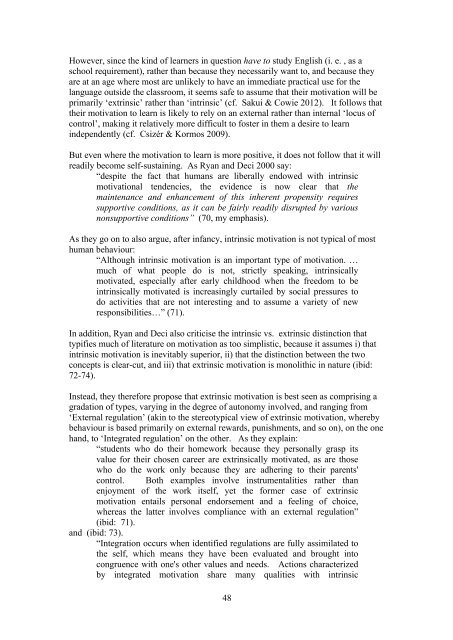RADICAL TEFL
2hqhXJd
2hqhXJd
You also want an ePaper? Increase the reach of your titles
YUMPU automatically turns print PDFs into web optimized ePapers that Google loves.
However, since the kind of learners in question have to study English (i. e. , as a<br />
school requirement), rather than because they necessarily want to, and because they<br />
are at an age where most are unlikely to have an immediate practical use for the<br />
language outside the classroom, it seems safe to assume that their motivation will be<br />
primarily ‘extrinsic’ rather than ‘intrinsic’ (cf. Sakui & Cowie 2012). It follows that<br />
their motivation to learn is likely to rely on an external rather than internal ‘locus of<br />
control’, making it relatively more difficult to foster in them a desire to learn<br />
independently (cf. Csizér & Kormos 2009).<br />
But even where the motivation to learn is more positive, it does not follow that it will<br />
readily become self-sustaining. As Ryan and Deci 2000 say:<br />
“despite the fact that humans are liberally endowed with intrinsic<br />
motivational tendencies, the evidence is now clear that the<br />
maintenance and enhancement of this inherent propensity requires<br />
supportive conditions, as it can be fairly readily disrupted by various<br />
nonsupportive conditions” (70, my emphasis).<br />
As they go on to also argue, after infancy, intrinsic motivation is not typical of most<br />
human behaviour:<br />
“Although intrinsic motivation is an important type of motivation. …<br />
much of what people do is not, strictly speaking, intrinsically<br />
motivated, especially after early childhood when the freedom to be<br />
intrinsically motivated is increasingly curtailed by social pressures to<br />
do activities that are not interesting and to assume a variety of new<br />
responsibilities…” (71).<br />
In addition, Ryan and Deci also criticise the intrinsic vs. extrinsic distinction that<br />
typifies much of literature on motivation as too simplistic, because it assumes i) that<br />
intrinsic motivation is inevitably superior, ii) that the distinction between the two<br />
concepts is clear-cut, and iii) that extrinsic motivation is monolithic in nature (ibid:<br />
72-74).<br />
Instead, they therefore propose that extrinsic motivation is best seen as comprising a<br />
gradation of types, varying in the degree of autonomy involved, and ranging from<br />
‘External regulation’ (akin to the stereotypical view of extrinsic motivation, whereby<br />
behaviour is based primarily on external rewards, punishments, and so on), on the one<br />
hand, to ‘Integrated regulation’ on the other. As they explain:<br />
“students who do their homework because they personally grasp its<br />
value for their chosen career are extrinsically motivated, as are those<br />
who do the work only because they are adhering to their parents'<br />
control. Both examples involve instrumentalities rather than<br />
enjoyment of the work itself, yet the former case of extrinsic<br />
motivation entails personal endorsement and a feeling of choice,<br />
whereas the latter involves compliance with an external regulation”<br />
(ibid: 71).<br />
and (ibid: 73).<br />
“Integration occurs when identified regulations are fully assimilated to<br />
the self, which means they have been evaluated and brought into<br />
congruence with one's other values and needs. Actions characterized<br />
by integrated motivation share many qualities with intrinsic<br />
48


